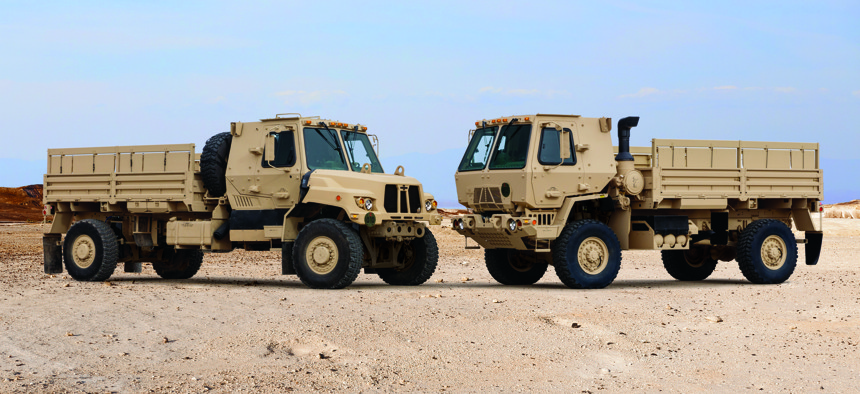
Family of Military Tactical Vehicles A2 trucks Oshkosh Defense
Defense Business Brief: Earnings preview; A Reagan Forum in DC; Boeing to develop NASA plane; and more.
This week’s earnings calls will be the first time we’ve heard from the CEOs of America’s largest defense firms since the new, split Congress has been seated—and since House Speaker Kevin McCarthy, R-Calif., apparently struck a deal with far-right Republicans that includes tens of billions of dollars in defense spending cuts.
It also will be the first time we’ve heard from industry leaders since Congress passed a fiscal 2023 appropriations measure that includes a 10 percent increase in defense spending. We’re likely to get updates on the supply chain, workforce, and inflation issues that have been affecting companies for the past three years.
“We believe that ‘able to execute’ may be a more important theme this upcoming earnings season than ‘well positioned,’” Capital Alpha Partners’ Byron Callan wrote in a Jan. 22 note to clients.
The earnings call schedule:
- Tuesday: Raytheon Technologies and Lockheed Martin
- Wednesday: General Dynamics and Boeing
- Thursday: Northrop Grumman
- Friday: L3Harris Technologies
The Ronald Reagan Institute, organizer of the annual Reagan National Defense Forum in Simi Valley, California, will hold a defense-industry-focused summit in Washington in March. The so-called National Security Innovation Base Summit will be at Reagan Institute’s Washington, DC, headquarters on March 14.
“The event is part of the Institute’s larger National Security Innovation Base (NSIB) program, which convenes key stakeholders to evaluate ways to improve the coordination and resilience of the national security innovation ecosystem,” the organization said in a statement. “The Summit will feature in-person panels and discussions among members of Congress, Department of Defense officials, defense industry and dual-use technology companies, investors, national security experts, and other thought leaders.”
The summit will launch the National Security Innovation Base Report Card, “an innovative policy tool developed by the Reagan Institute to measure the effectiveness, productivity, and resilience of our nation’s innovation ecosystem and provide recommendations for improvement.”
Welcome
You’ve reached the Defense Business Brief by Marcus Weisgerber. Send along your tips and feedback to mweisgerber@defenseone.com or @MarcusReports. Check out the Defense Business Brief archive here, and tell your friends to subscribe!
The U.S. Army has placed a $141 million order for 414 Family of Medium Tactical Vehicles A2 trucks and 56 trailers. The A2 versions have increased force protection, greater payload capacity, superior off-road mobility, enhanced engine power, and an upgraded electrical system,” according to truck-maker Oshkosh Defense. “These advanced capabilities allow the FMTV A2 to support a wide range of duties, from combat missions and logistics operations to aiding in relief efforts.”
Over the next seven years, NASA will invest $425 million in what it calls the Sustainable Flight Demonstrator project—an effort to develop a “new generation of green single-aisle airliners.” Boeing and other companies will invest $725 million “to build, test, and fly a full-scale demonstrator aircraft and validate technologies aimed at lowering emissions” which could one-day replace the 737 and even the 757. “Single-aisle aircraft are the workhorse of many airline fleets, and due to their heavy usage, account for nearly half of worldwide aviation emissions,” the space agency said. “NASA plans to complete testing for the project by the late 2020s, so that technologies and designs demonstrated by the project can inform industry decisions about the next generation of single-aisle aircraft that could enter into service in the 2030s.” Boeing was planning to design a 757 replacement, but late last year it indefinitely put off plans for that new mid-size aircraft as it looked to stabilize its 737 Max and 787 Dreamliner production lines.
The U.S. military flies several different versions of 737, most notably the Navy’s P-8 submarine hunter. The U.S. Air Force flies a VIP, business jet version of the 737, and is in the early stages of buying the E-7, an airborne early warning version of the twin-engine, single-aisle plane. The Navy also flies passenger or cargo versions of the 737.
The U.S. Army’s Next Generation Squad Weapon rifle has been given a new designation, XM/M7. In March 2021, the Army began calling the gun the XM5. “Since then, the service learned that the M5 name is used by Colt Industries for one of its 5.56mm carbines,” the Army said in an emailed statement “As a result, the NGSW Rifle will now be called the XM/M7.”
MAKING MOVES
James Swartout, most recently director of national security policy at the MITRE Corp., has returned to the Pentagon as a senior advisor to Bill LaPlante, undersecretary of defense for acquisition and sustainment. During the Obama administration, Swartout was chief of staff to Air Force Undersecretary Lisa Disbrow, as well a spokesperson for Deputy Defense Secretary Ash Carter.
Spirit AeroSystems has named Mark Miklos senior vice president of the company’s defense and space business. Miklos will replace Duane Hawkins, president of the defense and space business, after Hawkins retires at the end of March. Miklos was the president of FMI, a Maine-based company specializing in hypersonic technology acquired by Spirit in 2020.
HawkEye hired Patrick Zeitouni, former head of space mobility at Blue Origin, to be its chief strategy officer.




